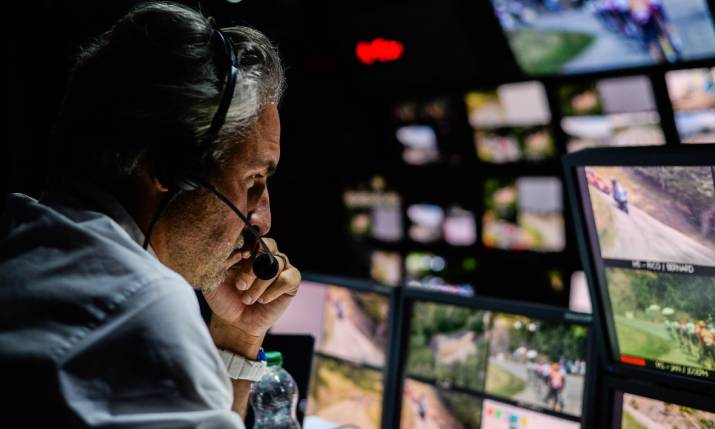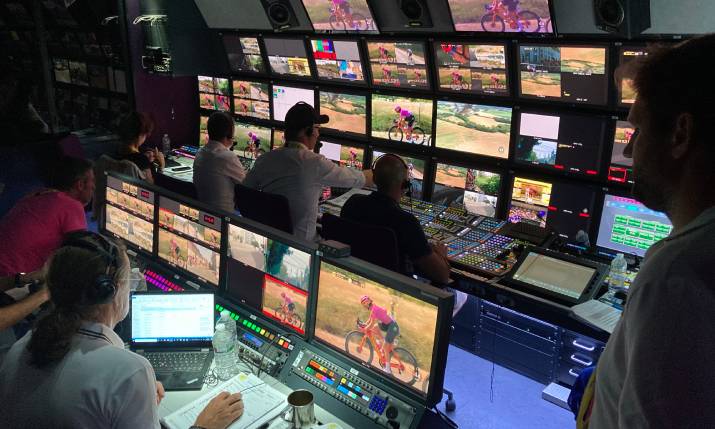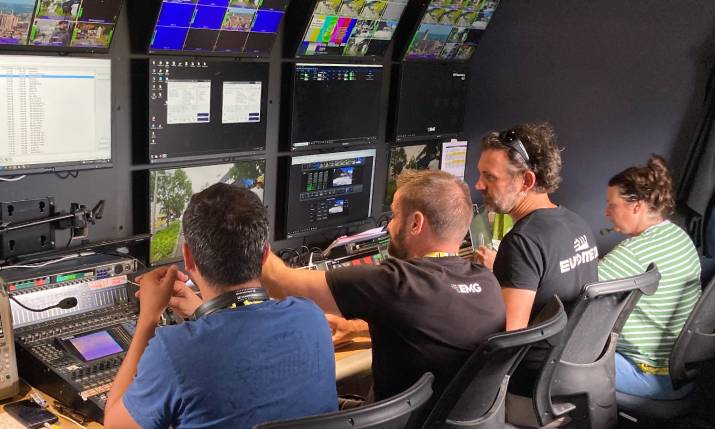Live from the Tour de France Femmes 2023: Behind the scenes with race director Philippe Letourneur

Philippe Letourneur is the race director for the 2023 Tour de Femmes
The sun is shining in Blagnac, on the outskirts of Toulouse. The finish arch is ready to welcome the victorious cyclist of the sixth stage of the Tour de France Femmes, just a few meters away from the TV compound. The indicator light is red {ON AIR}. The live broadcast is about to begin. Inside the France Télévisions production truck, there is a buzz of activity.
“Three, two, one… we’re going live… HF1 on air.” It is 3:20pm on Friday 28 July and race director Philippe Letourneur takes control of the international broadcast.
In the semi-darkness of the France Télévisions production truck, his face is illuminated only by the screens in front of him. The sixth stage of the 2023 Tour de France Femmes has already been underway for 50 minutes. However, due to budget constraints, the live broadcast has been delayed.
The opening sequence is played. Footage from the start is sent, along with some pre-race interviews. Then the director switches to the live images from the peloton, which has already covered about thirty kilometres.
“Moto 1 on air.” Letourneur has at his disposal three motorbike-mounted cameras linked via RF from EMG. He is focused and attentive, choosing which camera to include in the broadcast, staring closely at the wall of screens before him. Amid the pressure and excitement of live broadcasting, he remains calm. If a cameraman frames a shot incorrectly, or a graphic overlay is not perfect, he speaks with a neutral but firm tone, “we’re not in rehearsal, guys”. The message is clear, everyone needs to stay focused on their tasks.
Read more about EMG’s production for the Tour de France and the Tour de Femmes here

Inside the outside broadcast vehicle for the Tour de Femmes there is a bustle of activity around TV director Philippe Letourneur. In the foreground (in white), Jean-Francois Kerckaert, editor-in-chief
Significant allies
In addition to the three motorbike-mounted cameras, a helicopter equipped with a gyro-stabilised camera provides stunning aerial shots which are essential for a comprehensive view of the race.
In terms of the sport and strategy, Letourneur is assisted by Paul Brousse, the coach of the French women’s cycling team, a significant ally in identifying lesser-known riders compared to the male peloton. Sitting to the left of the director, Brousse has his own wall of screens to quickly follow race developments. He does not hesitate to alert the director about an attack, a crash, or a remarkable action. Between them, there’s a sense of complicity and trust.
At 4:01pm, Brousse exclaims, “attack on motorbike two!” Letourneur asks the journalist, “Nicolas, did you hear that?” and signals in his headset, “motorbike three, move up, we’re looking for cyclist number 55.” A true team effort. Brousse, for whom this is his first experience as a TV consultant, confides off-camera, “I didn’t realise there was all this behind the cameras.”

Concentrating, Tour de Femmes director, Philippe Letourneur, always has his roadbook in front of him, previously prepared to follow the aerial plans of the French territory
Tour of the France
As well as providing great shots of the Tour de Femmes, the helicopter also has a cultural role. Letourneur likes to paraphrase the words of the historical Tour de France TV director, Jean-Maurice Ooghe, “we don’t show the Tour de France, but the Tour of the France”. In addition to the sporting aspect, the goal of the production is to showcase French landscapes and landmarks.
Prior to the race, Letourneur mapped out the entire route and noted all the notable sites in a roadbook. This document is shared with the RF teams to plan helicopter movements. Before the race, Brousse also consulted with Amélie Pouderoux, a production manager at EMG, to validate possible helicopter routes based on flight plans and fuel reserves. The script supervisor, seated to the left of Brousse in the production truck, also keeps an eye on the roadbook and the real time position of the helicopter. She checks if the graphics displaying the site’s name are correct, informs the journalist of passing over a castle, a lake, or an abbey, so the journalist can prepare her commentary. On that day, several uncertainties will arise: “Are we sure that’s Castelnau de Montmirail?”
Indeed, during the live broadcast, Philippe Letourneur must maintain his attention, especially since he is sending two different feeds simultaneously: the international broadcast and the private France Télévisions broadcast.
He is aided by the graphics operator. France Télévisions provides a different programme with commentary from its journalists, as well as editorial additions such as pre-recorded interviews and advertisements during the live broadcast. Positioned behind the director, Jean-Francois Kerckaert, the chief editor, warns, “attention, commercial break in two minutes”.

Inside the EMG RF vehicle for the Tour de Femmes 2023 technicians ensure the transmission of images from motorcycles and the helicopter to the production OB van
Last kilometre
It is 5:26pm and only 4.2 kilometres remain before the finish line. Two riders, Emma Jorgensen and Polish cyclist Agnieszka Skalniak-Sojka, break away. In the director’s earpiece, a command is given to the camera operators: “Paul says they’re attempting it, be careful not to miss it.”
This change in camera plans occurs as the finish line approaches. The motorbikes are forced to park several hundred meters away, making way for stationary and RF cameras placed over the final meters. A camera is set 100 to 150 meters before the finish line, but the most important one, according to Letourneur, is the one placed higher up, around fifty metres past the finish line, capturing the crucial shot of the winner’s raised arms.
“Last kilometer,” sports journalist Nicolas Geay enthuses on-air. The tension is palpable. “Camera five, go!” Letourneur announces in the OB van. Camera five, one of the initial fixed cameras, signifies the start of the sprint.
Everything accelerates. There are only 500 meters left. A major crash in the peloton disrupts both the riders and the broadcast. “Camera seven… Who won?” Letourneur questions. Brousse responds, “number four,” referring to Jorgensen, who is victorious after 122.1 kilometres of racing. The footage from the Superloupe camera is sent to the broadcast. The emotion of victory is even more pronounced in slow motion.

After the race, a TV studio runs a live broadcast of the winners of that leg of the Tour de Femmes on France Télévisions, using a large sensor camera
Yellow jersey
The production continues for a few more minutes. Reactions and replays follow. At 5:44pm, there is another change in the production: France Télévisions hosts a post-race TV debrief. The script supervisor warns, “nine minute show, no overruns possible”. Meanwhile, the international signal continues to be produced in the production truck.
Just a few meters away, a proper TV show set is set up near the finish line, complete with a desk, lights, and multiple cameras. Four journalists and consultants, including Brousse who has just emerged from the production truck, provide live commentary on the key moments of this sixth stage. An RF camera with a large sensor, mounted on a Ronin gimbal, provides ultra-stabilised images with depth of field.
A few minutes later, from a truck adorned with Tour de France colours, the yellow jersey rider approaches the podium. The images are captured by a camera wired to the production truck, providing wide shots and close ups. The cyclists on the podium are also interviewed inside the yellow truck. In this interview area, a PTZ camera captures the reactions of the athletes for both the international and private broadcasts.
It is now 5:55pm and Letourneur and his team conclude the broadcast. Technicians and editorial teams exit the production truck. They discuss the race, the footage, the hiccups, and they smoke a cigarette and laugh. The end of the day… well, not exactly, because the Tour de France Femmes is a traveling production over several days.
They need to hit the road quickly. Tomorrow, they face the stage of the legendary Tourmalet pass. The GPS indicates a 2.5 hour journey to reach the summit. The day is far from over.

